The Australian macadamia nut is one of the most expensive foods in the world. Once only available in its homeland, these "royal nuts" are now imported to Europe. Most often, they are sold in their shells, which account for up to 50% of the total weight. This isn’t done for profit — the shell protects the kernels from oxidation, extends shelf life, and enhances flavor.
After shelling the nuts, a significant amount of shell remains, which has a pleasant aroma and a slightly sweet taste. Instead of throwing them away, macadamia shells can be repurposed in many useful ways.
This article explores how to properly use macadamia nut shells, their benefits, and potential drawbacks.
Table of contents
Composition and Nutritional Value of Macadamia Nut Shells
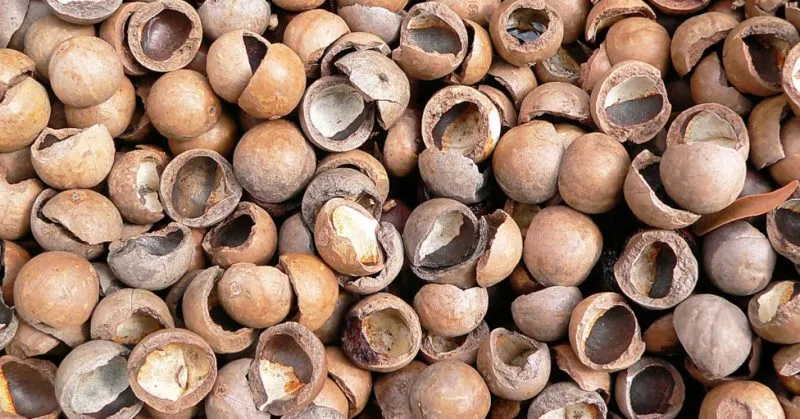
Macadamia is among the healthiest nuts on the planet. It contains vitamins, minerals, healthy fats, and acids, offering numerous health benefits.
While the edible kernels are the most nutritious part, the shells — often discarded — also contain valuable compounds.
These include:
- B vitamins;
- Minerals: zinc, potassium, selenium, phosphorus, calcium, copper, molybdenum, iron;
- Lignin;
- Cellulose;
- Ash;
- Essential oils.
The shell’s moisture content is around 10%. Despite this, it is so hard that cracking it without specialized tools is nearly impossible.
Fun fact! Thanks to their high essential oil content, macadamia shells burn well and for a long time.
The shells are light brown or chocolate-colored and share the kernel’s vanilla or chocolate aroma. When tasted, they have a subtle sweetness.
Whole shells are spherical. Processing factories make a precise cut along the shell, allowing it to split neatly into two halves.
Benefits and Risks of Macadamia Shells
Before repurposing macadamia shells, it’s important to understand their advantages and potential drawbacks.
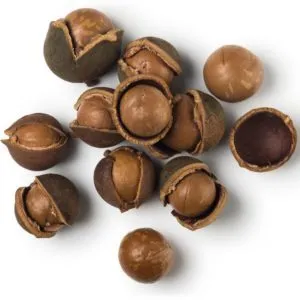
Health benefits of macadamia shell-based remedies:
- Detoxify the body by removing waste, toxins, and bad cholesterol. They help with poisoning recovery and prevent atherosclerosis and other vascular diseases.
- Reduce inflammation. Shell infusions can aid in treating respiratory infections.
- Speed up tissue regeneration. When applied topically, they promote wound healing and prevent infection.
- Improve digestion and intestinal motility.
- Have antibacterial and immune-boosting effects, helping fight colds and viral infections.
- Enhance skin, hair, and nail health, especially when used both internally and externally.
- Strengthen bones and joints, providing calcium and essential cofactors for its absorption.
Potential risks and contraindications:
- Nut allergies. Even macadamia shells can trigger severe allergic reactions.
- Children under three years old, due to higher allergy susceptibility.
- Pregnancy and breastfeeding, as macadamia may cause allergies in infants.
- Flare-ups of chronic stomach or intestinal conditions, as shells may worsen symptoms.
- Toxicity to pets, especially dogs, potentially causing paralysis.
In these cases, macadamia shells should be avoided. Even for general use, moderation is key.
Uses for Macadamia Nut Shells
What can you do with macadamia shells? Turns out, they have a wide range of applications.
The shells are used in traditional medicine, cosmetics, cooking, and even crafts. Their rich essential oil content also makes them valuable in industrial settings.
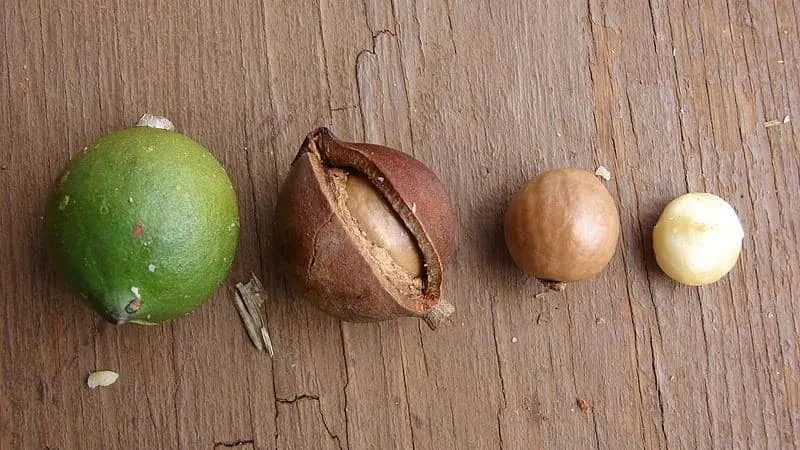
Industrial Applications
The tough shells are utilized in various industries. All byproducts from macadamia processing are repurposed:
- Activated charcoal. Compressed, finely ground shells are more effective at detoxification than standard charcoal.
- Industrial fuel. The high oil content makes shells an efficient, long-burning energy source. Many processing plants use them to power drying and heating systems.
- Engineered wood. Macadamia-based particleboard is a premium, durable material resistant to moisture, microbes, mold, and fungi. It’s ideal for bathrooms, saunas, and pool decks, with the added bonus of a pleasant natural scent.
- Construction. Crushed shells reinforce concrete mixtures, enhancing strength.
- Fertilizer. Packed with nutrients, shells enrich soil for healthier plant growth.
- Biodegradable plastic. Powdered shells are used to create eco-friendly, high-strength plastics.
Despite these uses, macadamia shells aren’t widely adopted in industry due to limited global production. Most applications remain concentrated in nut-growing regions.
Cosmetic Uses
Macadamia shells are prized in skincare for their exfoliating, rejuvenating, and circulation-boosting properties. Major cosmetic brands incorporate them, and they’re also great for DIY treatments.
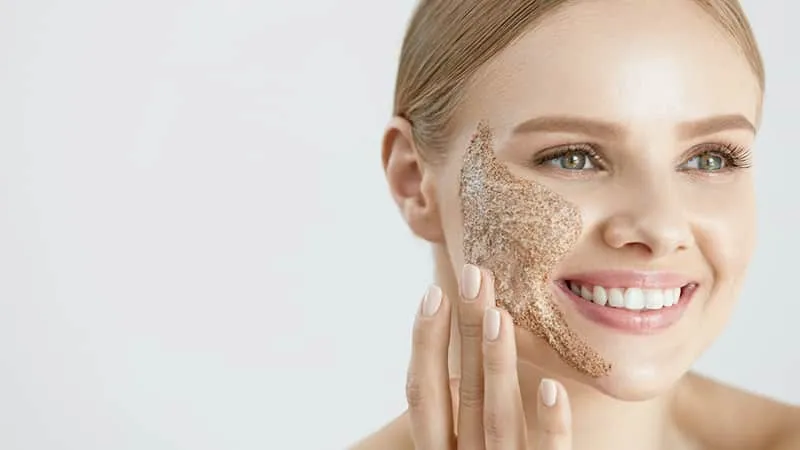
Cosmetic applications:
- Facial scrub. Grind shells into a fine powder and mix with face cream or sour cream. Gently massage onto skin for a few minutes, then rinse with warm water.
- Anti-cellulite scrub. Combine 1 tbsp shell powder, 1.5 tbsp olive oil, 5 drops each of rosemary and grapefruit essential oils. Massage onto problem areas for 3–5 minutes, leave for another 5 minutes, then rinse.
- Rejuvenating mask. Mix equal parts finely ground shells and white clay, then blend with cream (for dry skin) or coffee (for oily skin) to a creamy consistency. Apply to face and neck for 15 minutes, rinse, and follow with moisturizer.
Medicinal Uses
Alcohol-based tinctures made from macadamia shells have a sweet, vanilla or chocolate flavor (depending on the nut variety). Some recipes include additional ingredients.
Medicinal properties:
- Relieves headaches and migraines.
- Boosts immunity during colds.
- Helps regulate blood pressure.
- Promotes post-illness recovery and overall vitality.
Shell tinctures should only be taken under medical supervision. Those avoiding alcohol should opt for shell decoctions with similar benefits.
Note: Beyond medicinal use, macadamia shell tinctures are also enjoyed as a unique alcoholic beverage.
How to make a macadamia shell tincture:
- Classic vodka tincture: Combine 500 ml vodka, 50 g shells, and 1 tbsp caramelized sugar. Infuse in a dark place for two weeks, shaking occasionally.
- Aromatic moonshine version: Mix 500 ml moonshine, 40 g shells, 1 tsp vanilla extract, 1 tbsp sugar, and orange zest. Infuse for 14 days, shaking regularly.
- Medical alcohol tincture: Blend 1 cup medical alcohol, 1 cup purified water, and 50 g shells. Infuse for 10 days, shaking daily.
For health purposes, take 1 tsp (increasing to 1 tbsp) three times daily after meals.
Those avoiding alcohol can prepare a shell decoction with similar effects:
- Rinse shells and place in a pot.
- Add 50 g shells to 1 liter water, bring to a boil.
- Simmer covered for 20 minutes on low heat.
- Strain and store in the refrigerator.
Drink 3 times daily before meals.
Tip: Adding shell decoction to bathwater helps relieve stress, fatigue, and boosts immunity.
Culinary Uses

Shells can enhance your cooking. Many enjoy them in tea:
- Steep 50 g ground shells in 1 liter boiling water for 15 minutes.
- Sweeten with honey or sugar to taste.
Shell tinctures add a warm, spicy note to baked goods. Powdered shells work well as a spice, particularly in mulled wine.
Crafts and Decor
Whole shell halves make charming needle holders, miniature boats, or candle holders.
Creative ideas:
- Scented sachets: Fill a fabric pouch with shells, cinnamon sticks, and vanilla pods for long-lasting fragrance.
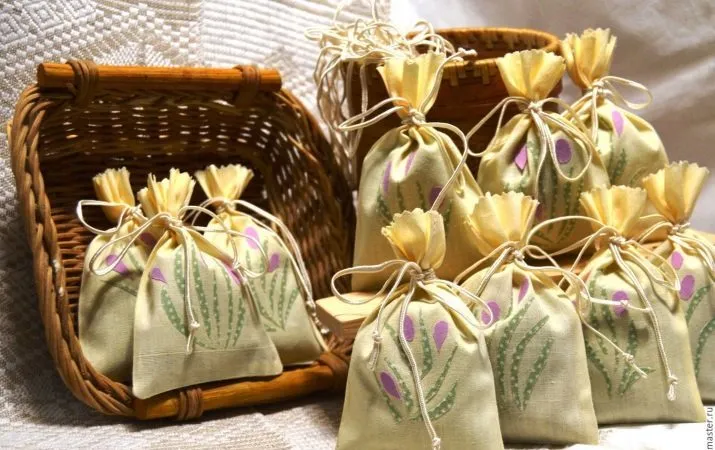
- Keychains: Drill a small hole in a shell half, thread wire through (securing a bead inside), and attach keychain hardware.
Conclusion
Macadamia nuts are often sold in-shell to preserve freshness. While shells add to the cost, they shouldn’t be wasted. Rich in beneficial compounds, they offer countless uses — from health remedies to home decor. With a little creativity, you can give these "leftovers" a second life.







